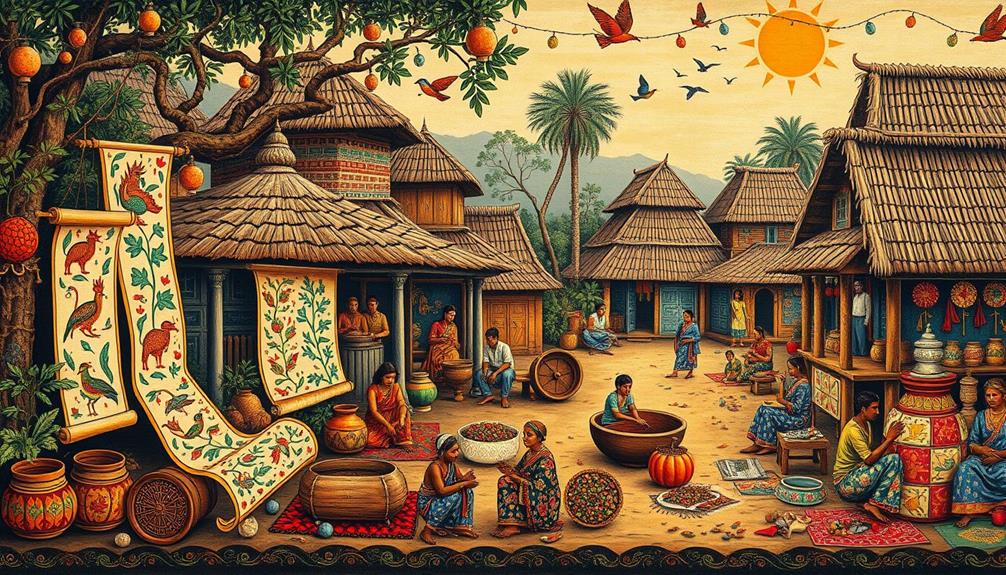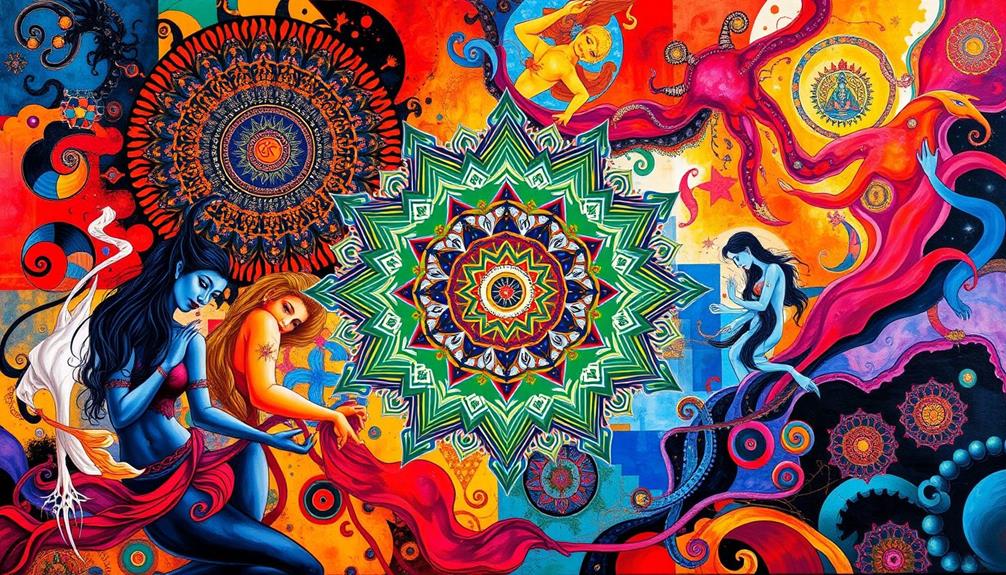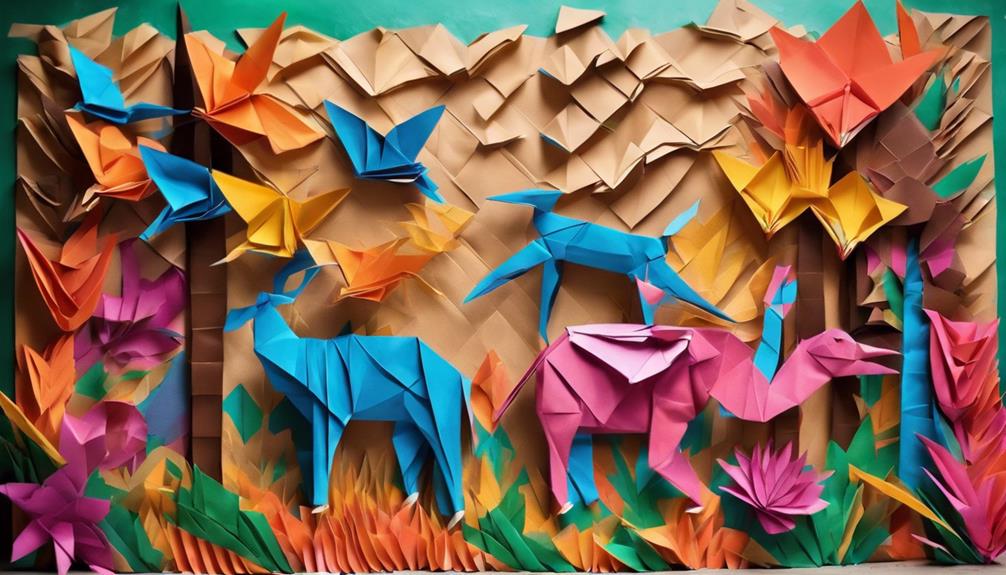In contemporary Indian practice, you'll find a fascinating blend of craft and fine art. Artists like Bharti Kher explore social issues using traditional techniques, challenging outdated distinctions. This merging highlights craftsmanship's role in cultural identity and sustainable practices. Textiles and ceramics showcase both history and modern innovation, offering new meanings and narratives through artistry. Women artisans are increasingly recognized, asserting their place in a male-dominated fine art scene. This dynamic environment invites you to reconsider what defines art and craft, showing how contemporary voices are shaping the future of this intersection in unique ways.
Key Takeaways
- The distinction between craft and fine art in India is being challenged, highlighting the cultural significance of craftsmanship alongside artistic expression.
- Contemporary Indian artists blend traditional techniques with modern themes, redefining the boundaries of craft and fine art.
- Sustainable practices in craft and design reflect current ethical trends, fostering a connection between cultural heritage and environmental consciousness.
- Initiatives promoting gender equity are spotlighting the contributions of women artisans, enhancing representation in both craft and fine art sectors.
- Personal narratives in contemporary art utilize traditional craft techniques, merging individual experiences with broader cultural themes and social issues.
Historical Context of Craft and Fine Art
Historically, the distinction between craft and fine art has been shaped by societal norms and gender roles, often sidelining craft as mere women's work. This marginalization stems from a long-standing belief that craft emphasizes functionality, while fine art, typically dominated by male artists, is viewed as more prestigious and devoid of practical purpose.
In India, the rich history of craftsmanship encompasses textiles, pottery, and metalwork, showcasing deep cultural significance that intertwines utility with aesthetic appeal. The contemporary movement towards natural materials like wood and stone in design further emphasizes the value of craftsmanship in creating lasting beauty.
As you investigate this historical context, you'll notice how craft has been undervalued despite its importance. The traditional definitions have created barriers, limiting recognition for artisans who create beautiful, functional pieces.
However, contemporary Indian artists are increasingly challenging these boundaries. They incorporate traditional craft techniques while addressing modern themes, thereby blurring the lines that once separated craft from fine art.
This shift reflects a growing movement advocating for the recognition of craft as a legitimate form of artistic expression. As you explore this evolving landscape, you'll see a greater appreciation for artisans and their work within the contemporary Indian art scene, reshaping perceptions and redefining artistic value.
Contemporary Indian Ceramics

Contemporary Indian ceramics exemplify the fusion of traditional craftsmanship with modern artistic expression, embodying both cultural heritage and innovative design. As you explore this vibrant field, you'll notice how artists like Ranjani Shettar and Bharti Kher use ceramics to investigate themes of identity, memory, and pressing social issues. Their works often incorporate mixed media and unconventional forms, pushing the boundaries of what ceramics can represent within Indian arts.
Additionally, the incorporation of sustainable practices in crafting ceramics is increasingly important, mirroring trends in vegan food options and trends that emphasize ethical production. The revival of regional practices, such as terracotta from Gujarat and stoneware from Karnataka, showcases the rich diversity in materials and techniques employed by contemporary artisans. This variety not only enhances the aesthetic appeal but also reinforces the connection to India's cultural roots.
Moreover, exhibitions and art fairs in India increasingly highlight ceramic works, promoting awareness and appreciation for this medium as a significant component of contemporary art discourse. Educational initiatives and workshops are also on the rise, nurturing a new generation of artisans who are adept at merging traditional craftsmanship with contemporary design sensibilities.
Together, these elements reflect the dynamic landscape of contemporary Indian ceramics, where tradition and innovation coexist beautifully.
Textile Innovations and Heritage

Textiles in India represent a vibrant tapestry of innovation and heritage, where age-old techniques intertwine with modern aesthetics. You'll find that contemporary Indian textile practices often merge traditional weaving with innovative designs, showcasing the significance of heritage while embracing current trends.
Artisans are increasingly turning to sustainable materials and eco-friendly processes, reflecting a rising awareness of environmental issues in textile production. This emphasis on sustainability mirrors the growing recognition of the importance of physical engagement and environmental connection, much like how play promotes environmental awareness.
The revival of ancient crafts, such as handloom weaving and block printing, is gaining traction through various initiatives aimed at preserving cultural identity and empowering local artisans. By supporting these efforts, you contribute to keeping these essential arts and crafts alive.
Collaborations between contemporary designers and traditional artisans lead to unique textiles that blend functionality with artistic expression, pushing the boundaries between craft and fine art.
When you explore Indian textile exhibitions, you'll see the diverse work of artists that promotes cultural narratives, emphasizing textiles as a powerful medium for storytelling and identity representation.
This intersection of innovation and heritage in textiles not only celebrates the past but also paves the way for a dynamic future in contemporary Indian art.
Craftsmanship and Material Exploration

Craftsmanship in India today is a vibrant fusion of tradition and innovation, where artisans are redefining boundaries and exploring new materials. You're witnessing a dynamic shift as contemporary Indian practice blurs the lines between craft and fine art.
Artists like Kevin Oyen and Ragnhild Hjalmarsdottir Højgaard exemplify this evolution, merging traditional techniques with modern aesthetics. Their work emphasizes the importance of materiality, showcasing how craftsmanship can adapt over time. This exploration of materials can be likened to the use of essential oils in aromatherapy, where natural elements are harnessed for their therapeutic benefits.
Take note of Højgaard's use of indigenous materials like Faroese wool, which reflects a commitment to sustainability and cultural heritage. This not only enriches the craft but also aligns with contemporary values. Similarly, Giulia Cosenza's exploration of ceramics reveals a dual focus on functionality and aesthetics. Her pieces intertwine everyday rituals with deeper symbolic meanings.
In this vibrant landscape, craftsmanship isn't just about preserving cultural traditions; it challenges conventional categorizations of art. You'll find that artisans push the boundaries of creativity and expression, creating work that resonates on multiple levels.
This ongoing material exploration invites you to reconsider what defines art and craft, making it an exciting time for both creators and appreciators alike.
Cultural Identity Through Craft
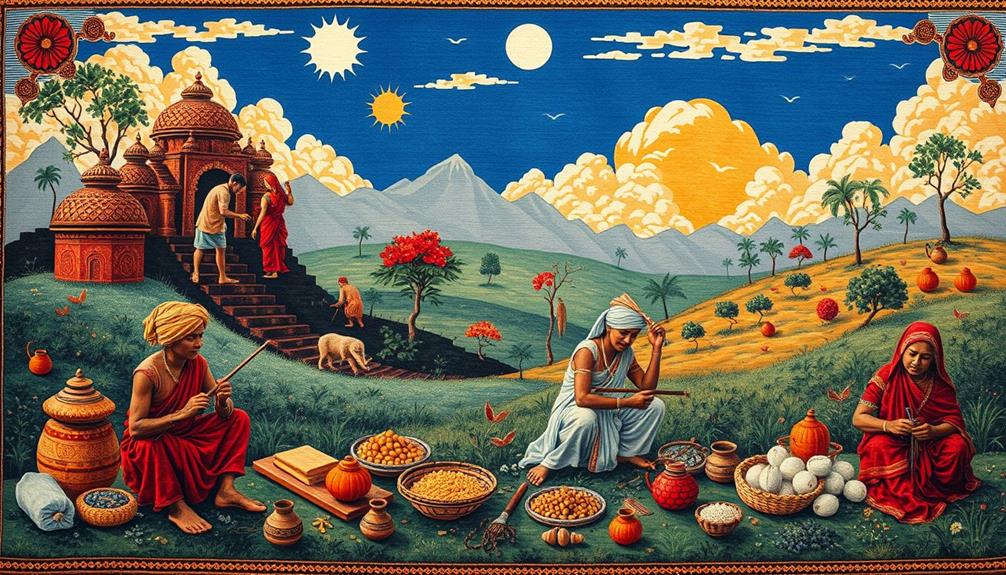
Cultural expression through craft serves as an essential lens for understanding identity in modern India. You'll find that contemporary Indian practice often blends traditional techniques with modern sensibilities, reflecting the evolution of society. As the interest in indigenous crafts resurges, artisans reclaim their narratives and assert their cultural identity amid globalization and mass production.
This intersection of tradition and innovation is akin to how cats exhibit signs of attachment to their owners, showcasing a deep emotional connection that resonates with cultural roots.
Exhibitions like "CraftSymbol" highlight craftsmanship's importance in cultural identity, showcasing how both Indian and Turkish practices celebrate unique local traditions. These events emphasize the role of craft in preserving and communicating cultural narratives.
Furthermore, initiatives like Ethnicloom integrate sustainable practices in textile design, reinforcing the connection between cultural identity and environmental stewardship.
You can see that contemporary Indian artists often use craft techniques to address social issues, creating works that resonate with both personal and collective identities. This bridging of tradition and modernity allows them to articulate cultural identity in a dynamic way.
Gender Representation in Design
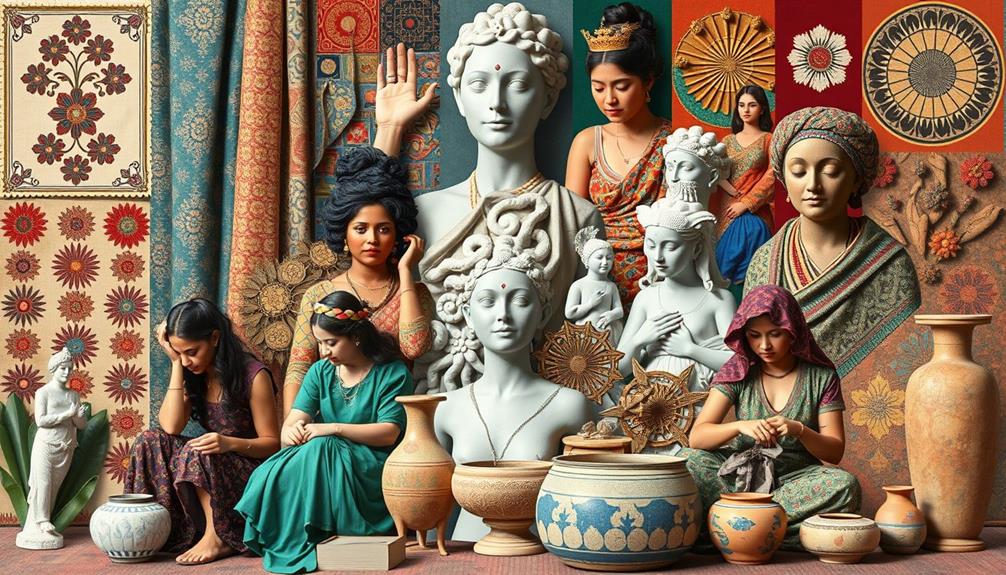
Equity in design is a critical conversation in contemporary Indian art, as gender representation remains a pressing issue. Historically, women have been marginalized in the craft sector, while men have dominated fine art forms like painting and sculpture.
However, contemporary movements are challenging these norms, bringing attention to women designers and artisans who are redefining the boundaries between craft and fine art. These shifts can be compared to the way astrological compatibility affects romantic attraction, highlighting the complex dynamics of relationships within the arts community.
You might notice several initiatives pushing for change, such as:
- Celebrating women's contributions through events like International Women's Day.
- Showcasing female artisans in platforms like CraftSymbol, which highlights their essential role in cultural identity.
- Advocating for gender equality and inclusion in the arts community.
These movements create a platform for women in design to express their unique narratives, fostering a sense of belonging in a historically male-dominated space.
Personal Narratives in Art

Personal narratives in contemporary Indian art weave together individual experiences and collective cultural themes, creating a rich tapestry that speaks to both personal and societal issues. In a new exhibition, you might encounter artists who blend traditional craft techniques with their stories, making their pieces resonate emotionally and culturally.
Here's a glimpse into how various artists approach personal narratives:
| Artist | Focus Area |
|---|---|
| Āsa Jungnelius | Questions social constructs with symbolism |
| Giulia Cosenza | Merges everyday rituals in ceramic works |
| Various Artists | Explores themes of identity and heritage |
| Emerging Artists | Utilize socio-political contexts in their art |
| Established Artists | Reflect personal histories through craft |
The Future of Craft and Design
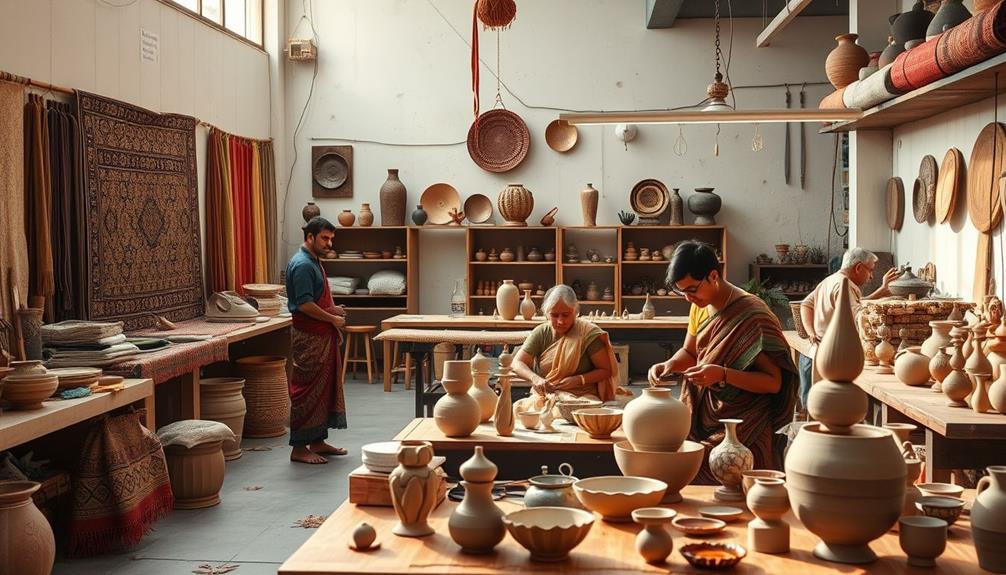
As we look toward the future of craft and design, a dynamic blend of traditional techniques and modern innovations is emerging. This evolution reflects a growing appreciation for craftsmanship, with sustainable practices at its core.
Designers are increasingly focused on minimizing environmental impact while preserving cultural integrity, leading to a richer craft narrative. In this regard, architects are also exploring innovative design and functionality, emphasizing collaboration with artisans and clients throughout projects, as seen in clientele includes homeowners and commercial developers.
You'll find that the future holds several exciting developments:
- Collaborative projects are uniting artisans from diverse backgrounds, fostering cross-cultural exchanges and enriching design narratives.
- The integration of technology, like 3D printing and digital design, expands creative possibilities and functional applications, allowing for innovative expressions in craft.
- Educational initiatives promote inclusivity and diversity, ensuring marginalized voices and practices are represented, giving the field a vibrant, multifaceted character.
This intersection of tradition and innovation invites you to explore new avenues in craft and design.
By embracing sustainable practices and fostering collaboration, you can contribute to a future that honors both heritage and the planet.
The landscape of craft and design is evolving, and it's an exciting time to be part of this transformative journey.
Frequently Asked Questions
What Is the Role of Traditional Indian Art and Craft in Contemporary Indian Society?
Traditional Indian art and craft enrich your society by preserving cultural heritage, providing livelihoods for artisans, and fostering community identity. Engaging with these practices, you connect with history while supporting local economies and sustainable development.
What Is the Indian Arts and Crafts Act All About and Why Is It Very Important to American Indians?
Imagine vibrant beadwork and intricate pottery, each telling a story. The Indian Arts and Crafts Act protects these treasures, ensuring only authentic Native creations shine in the marketplace, safeguarding cultural identity and supporting Indigenous artisans.
What Is the Purpose of the Indian Arts and Crafts Board?
The Indian Arts and Crafts Board aims to promote authentic Native American art, ensuring products are genuinely made by Native artisans. You'll find they provide resources, support, and education to foster cultural heritage and craftsmanship.
What Is the Contemporary Art Scene in India?
You'll discover a dynamic contemporary art scene in India, bursting with creativity. Artists tackle identity and globalization through diverse mediums, gaining global acclaim and transforming the cultural landscape. The excitement is palpable; you won't want to miss it!
Conclusion
In exploring the intersection of craft and fine art in contemporary Indian practice, you've seen how these forms intertwine to express cultural identity and personal narratives. Did you know that nearly 80% of Indian artisans rely on traditional methods passed down through generations? This statistic highlights the importance of preserving these practices in an ever-evolving art landscape. Embracing both craft and fine art not only enriches the creative dialogue but also honors the heritage and stories behind each piece.

